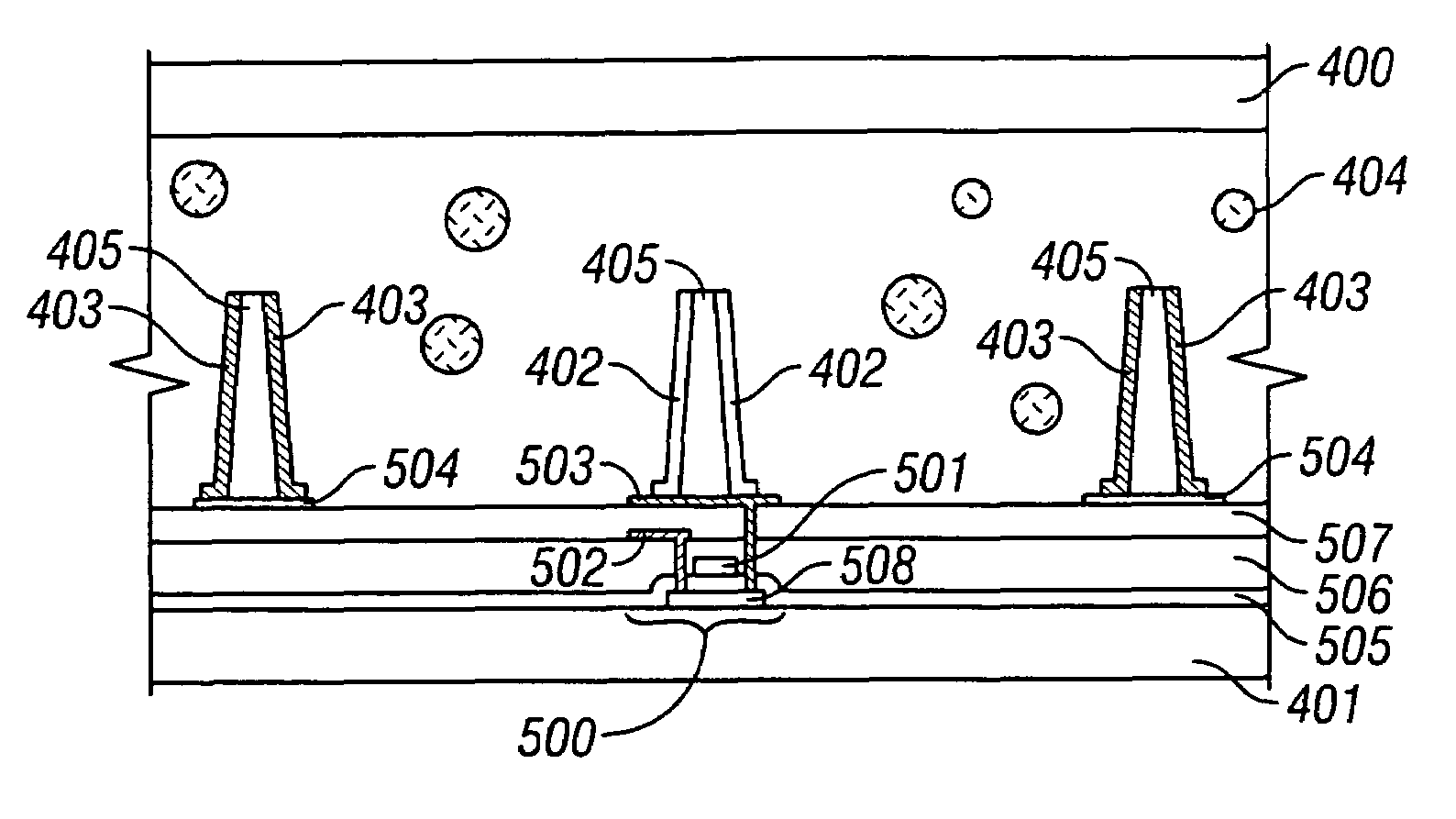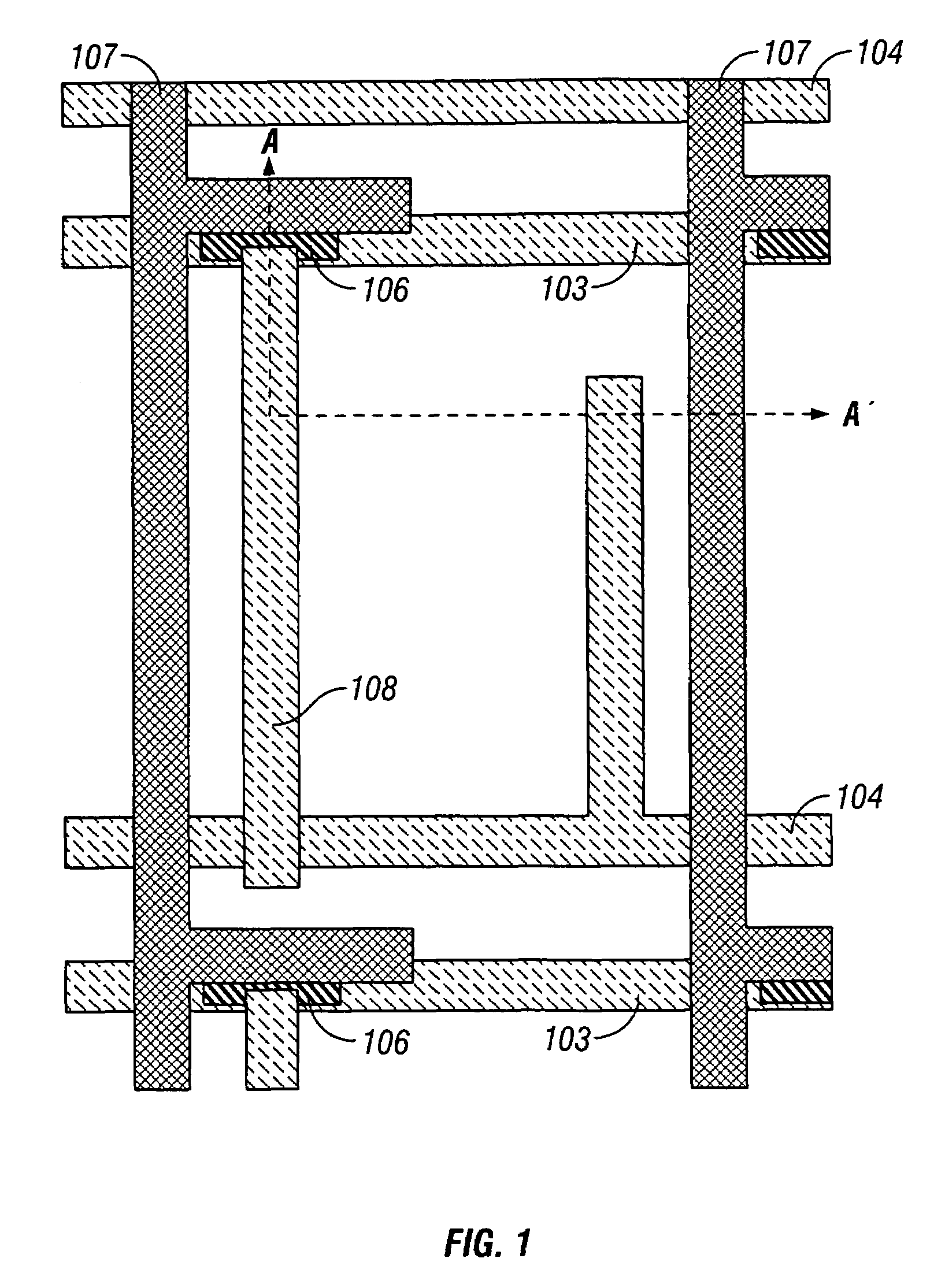Liquid crystal electro-optical device
a liquid crystal electrooptical and electrooptical technology, applied in optics, non-linear optics, instruments, etc., can solve the problems of liquid crystal alignment in the dark display state, decoloration phenomenon, and inability to accurately detect the color of the liquid crystal, etc., to achieve superiority in the effective utilization of light and high visual angle properties
- Summary
- Abstract
- Description
- Claims
- Application Information
AI Technical Summary
Benefits of technology
Problems solved by technology
Method used
Image
Examples
example 1
[0131]The present example describes the details of a process for fabricating a constitution according to the present invention with reference to FIGS. 1 and 2. More specifically, a case using a reverse stagger type thin film transistor as TFT is described.
[0132]Firstly, a silicon oxide film from 1,000 to 3,000 Å in thickness was formed as a base oxide film 102 on a Corning #7059 glass substrate 101 provided as an insulating substrate. The silicon oxide film can be formed, for example, by sputtering or by plasma CVD under an oxygen atmosphere.
[0133]Then, a Cr film for constituting a gate electrode 103 was formed at a thickness of from 1,000 to 5,000 Å. By patterning the Cr film, a pattern as a base for the gate electrode 103 can be formed.
[0134]Then, an isotropic plasma etching was performed thereafter by using a resist as a mask. Progressive etching was controlled and an electrode with a curved plane was formed by appropriately setting the discharge gas voltage. A gate electrode 103...
example 2
[0147]The present Example refers to a monolithic active matrix circuit whose peripheral drive circuit is also formed on the substrate. The process for fabricating the liquid crystal electro-optical device according to the present Example is explained below by making reference to FIGS. 3 and FIGS. 4(A) to 4(F).
[0148]Referring to FIG. 3 showing a scheme of the periphery of a pixel portion of the present Example. FIGS. 4(A) to 4(F) show the cross section taken along line B–B′–B″ in FIG. 3. In FIGS. 4(A) to 4(F), the left hand side shows the process steps for fabricating the TFT of a drive circuit, whereas the right side shows the process steps for fabricating the TFT of an active matrix circuit.
[0149]Firstly, a silicon oxide film was formed as a base film on a glass substrate 301. In the present case, a silicon oxide film was formed on a Corning #1737 glass substrate by sputtering method.
[0150]An amorphous silicon film was formed thereafter by plasma CVD or by LPCVD to a thickness of f...
example 3
[0176]The present Example explains in detail the constitution of a liquid crystal electro-optical device with reference to FIGS. 7(A) and 7(B). An active matrix circuit consisting of a thin film transistor 500 and a common electrode 403 is formed on a substrate 401. The constitution of the active matrix circuit is shown in FIG. 10.
[0177]In FIGS. 7(A) and 7(B), single pixel is defined by the effective area of an electric field formed between the electrodes 402 provided on both side planes of a support 405 constituting a wall, and the electrodes 403 provided on two supports 405.
[0178]The drain electrodes 402 were formed on both side planes of the wall 405 made from an insulating material. The drain electrode was insulated per pixel. Furthermore, a polyimide resin was used as the insulating material constituting the wall.
[0179]Referring to FIG. 7(A), an island-like silicon film 508 is provided on a glass substrate 401 having thereon an undercoat film (not shown in the figure), and an a...
PUM
| Property | Measurement | Unit |
|---|---|---|
| angle | aaaaa | aaaaa |
| width | aaaaa | aaaaa |
| width | aaaaa | aaaaa |
Abstract
Description
Claims
Application Information
 Login to View More
Login to View More - R&D
- Intellectual Property
- Life Sciences
- Materials
- Tech Scout
- Unparalleled Data Quality
- Higher Quality Content
- 60% Fewer Hallucinations
Browse by: Latest US Patents, China's latest patents, Technical Efficacy Thesaurus, Application Domain, Technology Topic, Popular Technical Reports.
© 2025 PatSnap. All rights reserved.Legal|Privacy policy|Modern Slavery Act Transparency Statement|Sitemap|About US| Contact US: help@patsnap.com



